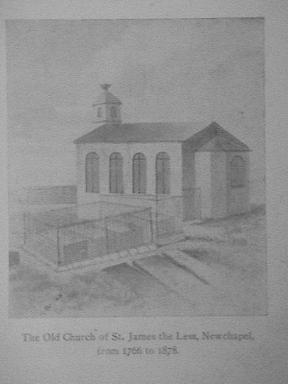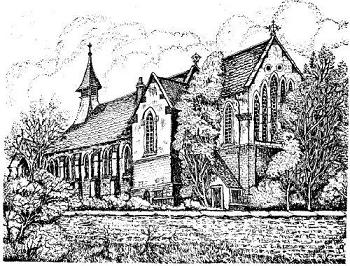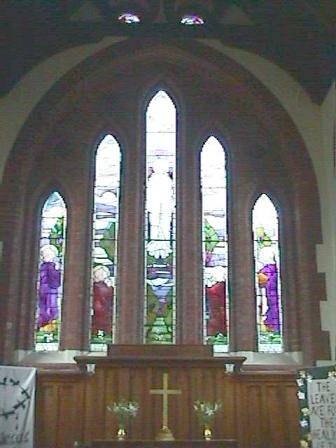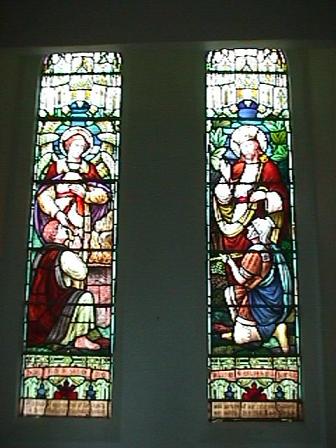
Before 1558 the area now known as Newchapel was called Thursfield (a more modern village of that name still exists within the current parish) and was then a part of the much larger parish of Wolstanton. In the reign of Edward I, a document called "Taxates Ecclesiastics" from the year 1288, states that a chapel was built at the cost of £26-13s-6d. This chapel may have been at Thursfield as there was no other in the parish of Wolstanton.
At the beginning of the reign of Queen Elizabeth I in 1558, a new Chapel of stone was built, so giving the village its present name. This chapel stood until the rebuilding in 1766/7. A new church was built in 1766/7 to replace the stone one and is described as being a modern and very plain brick building. The interior measured 48 feet by 36 feet. There was a large porch at the west end in which was a vestry room and a small gallery staircase. Over the gallery was a cupola bell tower containing one bell.
The church remained in the parish of Wolstanton and was a perpetual curacy until 14th July 1846 when it became a parish and the living a vicarage. The vicar at this time was the Rev. Thurston Forshaw who died in 1878 and is buried in the churchyard along with his son, daughter and wife. The vicarage was built in 1850 at a cost of £700.
The church was rebuilt in 1880 at a cost of £2,675 and this is the current church which was concecrated on 14th February 1880. The style is early English, and consisted of a nave with south porch. It has a western turret containing one bell and originally had seating for 300 people.
A chancel, vestries and organ chamber were added in 1914 at a cost of £1,370. The foundation stone was laid by Robert Heath Esq. whose family employed many men from the parish in the mines and forges. He built and owned many of the houses in which they lived. A Flemish window at the east end, depicting the Ascension was given by Mr W. Myatt. Choir stalls, pulpit and chancel screen were made by men of the villiage and four memorial windows were added in 1921. One window commemorates the fallen of the 1914-18 war, another window and a processional cross were presented to the church by the Wall's family of Packmoor.
During the 1950's the bell became unsafe and recording apparatus was presented to the church.
Inside the church, extensive alterations have taken place which reflect the church's aim to adapt to the needs of its contempory congregation. Thus the foyer and coffee bar area, a popular after service gathering spot, leads upstairs to fully fitted kitchen, meeting room and quiet prayer room. This utilisation of the roof space provides a venue for various church groups, from the elderly luncheon club, 'Tiddlers Toddlers & Friends' Club, Teenage groups and Sunday morning 'Trekkers' (Sunday School) group.
Directly opposite the church gates is situated the building which once housed Newchapel Free Grammer School, bequeathed by Dr. Robert Hulme of Sandbach in 1708. The house next to it was for the boys who boarded at the school to lodge in. Turning left from the church gates, walking down past the 'Grapes' public house, the building at the junction which is now Electrowind, once housed the National School, which was an Anglican system of education before the days of compulsory state education. The National School at Newchapel could take 240 children, but in 1896 the average attendance was 180, perhaps due to competition from the Board Schools. This building was for many years used by St James as its church hall until it was bought by Electrowind.
Acknowledgment - Some information of the early history taken from "The History of the Parish of Newchapel" by B. Machin
Our Stained Glass Window
St James Church has a group of Flemish windows which rise above the Holy Table at the East end of the church.
They depict the Ascension of Jesus from the Mount of Olives following his death, resurrection and appearances to the disciples and others. It stands in front of the congregation and is a constant reminder of the certain hope of new life in heaven that awaits all those who believe in Jesus. His disciples are around him and in two small round windows above the main group are images of heavenly cherubim.
The window was given by Mr William Myatt of Harriseahead in memory of his wife, Tamar Myatt in 1914.
1914-1918 Memorial Window
The pair of windows, on the North side of the church, were erected as a tribute of appreciation of the loyalty and service of our returned soldiers in their efforts for Englands honour and safety during the first world war 1914-1918.
The left-hand window has the caption Here I am, send me and echos the words of Isaiah chapter 6 verse 8 as he declared his willingness to answer Gods call.
The right-hand window has the caption Well done good and faithful servant, Gods words of appreciation and encouragement from Matthew chapter 25 verses 21 and 23 to those who use well the resources he gives them.
South Side Window
This window, on the South side of the church, shows Jesus carrying a lantern, and has the caption I am The Light of the World.
It was presented by the Wall family in loving memory of Henry, son of Joseph and Harriet Wall, who died 6th September 1957.
Miss Ester was a teacher at what was the National School (now a private dwelling) across the road from the church.
North Side Windows
One of the windows, on the North side of the church, shows Jesus as our Healer. It has the caption I say unto thee arise. A reminder that if we have need of healing, either physical or spiritual, then Jesus is both willing and able to meet our need.
The window was given in sweet remembrance of Lilian Dora Wright of Newchapel. Erected by the members of her family in 1921.
Church records show that Dora Wright died in 1917 aged 16 years. She lived in High Street, Newchapel and was possibly the daughter of the local policeman.
On the North side of the church there is also a window which shows Jesus as The Good Shepherd.
It was erected by the choir and parishioners in memory of Mr W.R. Green, late organist, choirmaster and schoolmaster of Newchapel.
At the beginning of the reign of Queen Elizabeth I in 1558, a new Chapel of stone was built, so giving the village its present name. This chapel stood until the rebuilding in 1766/7. A new church was built in 1766/7 to replace the stone one and is described as being a modern and very plain brick building. The interior measured 48 feet by 36 feet. There was a large porch at the west end in which was a vestry room and a small gallery staircase. Over the gallery was a cupola bell tower containing one bell.
The church remained in the parish of Wolstanton and was a perpetual curacy until 14th July 1846 when it became a parish and the living a vicarage. The vicar at this time was the Rev. Thurston Forshaw who died in 1878 and is buried in the churchyard along with his son, daughter and wife. The vicarage was built in 1850 at a cost of £700.
The church was rebuilt in 1880 at a cost of £2,675 and this is the current church which was concecrated on 14th February 1880. The style is early English, and consisted of a nave with south porch. It has a western turret containing one bell and originally had seating for 300 people.
A chancel, vestries and organ chamber were added in 1914 at a cost of £1,370. The foundation stone was laid by Robert Heath Esq. whose family employed many men from the parish in the mines and forges. He built and owned many of the houses in which they lived. A Flemish window at the east end, depicting the Ascension was given by Mr W. Myatt. Choir stalls, pulpit and chancel screen were made by men of the villiage and four memorial windows were added in 1921. One window commemorates the fallen of the 1914-18 war, another window and a processional cross were presented to the church by the Wall's family of Packmoor.
During the 1950's the bell became unsafe and recording apparatus was presented to the church.
Inside the church, extensive alterations have taken place which reflect the church's aim to adapt to the needs of its contempory congregation. Thus the foyer and coffee bar area, a popular after service gathering spot, leads upstairs to fully fitted kitchen, meeting room and quiet prayer room. This utilisation of the roof space provides a venue for various church groups, from the elderly luncheon club, 'Tiddlers Toddlers & Friends' Club, Teenage groups and Sunday morning 'Trekkers' (Sunday School) group.
Directly opposite the church gates is situated the building which once housed Newchapel Free Grammer School, bequeathed by Dr. Robert Hulme of Sandbach in 1708. The house next to it was for the boys who boarded at the school to lodge in. Turning left from the church gates, walking down past the 'Grapes' public house, the building at the junction which is now Electrowind, once housed the National School, which was an Anglican system of education before the days of compulsory state education. The National School at Newchapel could take 240 children, but in 1896 the average attendance was 180, perhaps due to competition from the Board Schools. This building was for many years used by St James as its church hall until it was bought by Electrowind.
Acknowledgment - Some information of the early history taken from "The History of the Parish of Newchapel" by B. Machin
Our Stained Glass Window
St James Church has a group of Flemish windows which rise above the Holy Table at the East end of the church.
They depict the Ascension of Jesus from the Mount of Olives following his death, resurrection and appearances to the disciples and others. It stands in front of the congregation and is a constant reminder of the certain hope of new life in heaven that awaits all those who believe in Jesus. His disciples are around him and in two small round windows above the main group are images of heavenly cherubim.
The window was given by Mr William Myatt of Harriseahead in memory of his wife, Tamar Myatt in 1914.
1914-1918 Memorial Window
The pair of windows, on the North side of the church, were erected as a tribute of appreciation of the loyalty and service of our returned soldiers in their efforts for Englands honour and safety during the first world war 1914-1918.
The left-hand window has the caption Here I am, send me and echos the words of Isaiah chapter 6 verse 8 as he declared his willingness to answer Gods call.
The right-hand window has the caption Well done good and faithful servant, Gods words of appreciation and encouragement from Matthew chapter 25 verses 21 and 23 to those who use well the resources he gives them.
South Side Window
This window, on the South side of the church, shows Jesus carrying a lantern, and has the caption I am The Light of the World.
It was presented by the Wall family in loving memory of Henry, son of Joseph and Harriet Wall, who died 6th September 1957.
Miss Ester was a teacher at what was the National School (now a private dwelling) across the road from the church.
North Side Windows
One of the windows, on the North side of the church, shows Jesus as our Healer. It has the caption I say unto thee arise. A reminder that if we have need of healing, either physical or spiritual, then Jesus is both willing and able to meet our need.
The window was given in sweet remembrance of Lilian Dora Wright of Newchapel. Erected by the members of her family in 1921.
Church records show that Dora Wright died in 1917 aged 16 years. She lived in High Street, Newchapel and was possibly the daughter of the local policeman.
On the North side of the church there is also a window which shows Jesus as The Good Shepherd.
It was erected by the choir and parishioners in memory of Mr W.R. Green, late organist, choirmaster and schoolmaster of Newchapel.
If you are looking for a place of rest St James' graveyard is now closed for new burials but is open for the internment of ashes for parishoners. It is essential you discuss this with both your Funeral Director and the Vicar of St James Church, who will be able to guide you, in terms of memorials, administration and costs.
| Year | Status | Name | Comments |
|---|---|---|---|
| 1533 | Curate | Thomas Tunstall | |
| 1604 | Reader | Unknown | A Reader without Orders |
| 1626 | Curate | William Bourne, M.A. | |
| 1634 | Curate | Ralph Tunstall | |
| 1641 | Curate | Richard Bourne, M.A. | |
| 1657 | Curate | Thomas Dresser | |
| 1658 | Curate | James Haydock | |
| 16?? | Curate | ?? Davenport | Ejected 1662 |
| ???? | Curate | Roger Hawson | Resigned? 1734 |
| 1734 | Curate | Ralph Baddiley | |
| 1741 | Curate | Thomas Malbon | |
| 1777 | Curate | Joshua Stonehewer | |
| 1790 | Curate | Ralph Morton | |
| 1799 | Curate | John Lawton | |
| 1832 | Curate | William Carter | |
Newchapel becomes a Parish and the living a Vicarage |
|||
| 1842 | Vicar | Thurston Forshaw | The first vicar of the parish. Died in 1878 and is buried in the churchyard |
| 1875 | Vicar | Thomas Frith Salmon | |
| 1885 | Vicar | Charles David Rae, M.A. | |
| 1892 | Vicar | John Parkinson Bygott, M.A. | |
| 1905 | Vicar | Elmitt Raithby Browne, M.A. | |
| 1908 | Vicar | Ernest Lloyd Stacey | |
| 1910 | Vicar | John Francis Hewitt, M.A. | |
| 1916 | Vicar | John George Hamlet, B.A. | |
| 1921 | Vicar | George Andrew Montagu Griffiths, M.A. | |
| 1927 | Vicar | John Lionel Monk, B.A., L.Th., Hon. C.F. | |
| 1949 | Vicar | Joseph John Williams | |
| 1955 | Vicar | Ronald Gordon Paisley | |
| 1961 | Vicar | Roger Lyne, M.A. | |
| 1965 | Vicar | Frank Dyson | |
| 1978 | Vicar | Edwin John Ablett | |
| 1983 to 1993 | Vicar | Paul Howard | |
| 1994 to 2016 | Vicar | William E. Slater | Appointed as Rural Dean 1999 |
| 1997 to 2000 | Curate | Nigel Irons | The first parish Curate working under the incumbant |
| 2001 to 2004 | Curate | Martin Stephens | |
| 2006 to 2009 | Curate | Christine Broad | |
| 2010 to 2013 | Curate | Lee Plummer | |
Copyright © St James 2002 - 2025
Website design by KiiRO Creative








